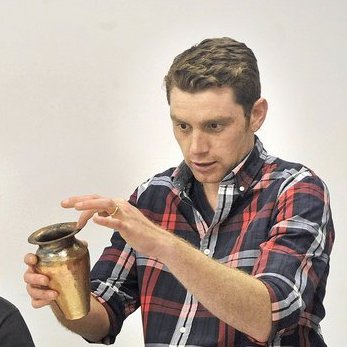
Jeffrey Clancy
Jeffrey Clancy is a visual artist and metalsmith living and working in the USA. He is part of a venerable lineage of smiths who have demonstrated stunning skill and innovative design in the manufacture of treasured utilitarian, ceremonial and decorative metalwares. Invested in questions about preservation and the acquisition of craft skill, he mines the field’s history, examining and dissecting it with uneasy reverence and then re-present it into new objects, images and, always, new questions.
If you had access to all the powers, how would you improve the world?
Well that’s a really big question with everything that has been happening but the one thing that I keep coming back to is access (food, education, health, money, housing, etc), and inclusively (race, religion, gender, etc). Change is difficult especially without lateral equity.
What are the biggest sustainability challenges in your work and how are you addressing them?
I think the general mining of precious metals and ore. I am able to recycle all of my materials either into new work or work with refiners who address sustainability as a priority to the planet.
Which conscious lifestyle choices are you making? And are you considering any new ones?
My family and I do our best to reduce our carbon footprint where we can like walking over driving (we drive a hybrid car), eating mostly food from renewable local and seasonal resources (including our own garden) and reduced animal proteins, just in general not wasting materials and stuff. There is definitely more that I wish we could do. In the future I would like to be able to have my home operate on solar. I am also talking with my 9 year old son about accountability and how the choices and actions he makes have an impact immediately and down the road as well as locally and globally.
What have you rebelled against in the past, and what are you rebelling against now?
I can’t say that I have intentionally rebelled against anything. I will say I have always done what I’ve wanted to do, my way. In regards to my work I have always worked from the perspective of a critical observer and constantly considering nuanced details and theoretical models that propose new questions and new objects.
Do you think tableware can still be improved? If yes, in what way?
Yes, I think if we considered table wares and utensils from the most basic understanding of function rather than a manufacturing, cultural, economic, social and material point of view we might be able to create new forms and objects as well as expressions and experiences. What if the spoon, knife and fork were considered in terms like to sever, spear and serve?
What was the inspiration for your Steinbeisser pieces?
The work was based on a previous series titled Residualwares so some of the visual cues and aesthetics are derived from that work. However, the challenge to create so many pieces to be used with other artists was what really motivated me.
Describe your work in 3 words!
Curious. Heavy. Grotesque.
What kind of materials do you use and where do you get them from?
Mostly precious metals.
What has been your favorite dinner experience?
Another Night of BS with Aaron T Stephan, I attended this in Portland in 2011. It was an amazing event by a very smart and talented artist whose practice is robust and prolific. He and his partner Lauren Fensterstock have done several exciting food based performance pieces. The text below is copied from his website. Another Night of BS with Aaron T Stephan is a performative event combining the efforts of several local artists. The performance begins with the audience seated in the center of a large room facing a stage. The artist begins a standard artist talk. As the talk proceeds, a group of carpenters begins to deconstruct the stage. These materials are used to build an ad-hoc kitchen to the right of the artist and a workbench to the left. Their work is choreographed, efficient, and loud. Once the kitchen is built, two cooks enter and begin making fresh pasta. As they progress, pasta is hung on racks creating a unique and growing visual presence on stage. The carpenters continue their work, building a set of tables for the audience – gradually transforming the space into a large dining room. During the final portion of the performance, the audience, artist, carpenters, and cooks join for a dinner that has been made through the duration of the performance.
What excites you about tomorrow?
What I get done today.
What are your 3 favorite pieces on Jouw…?
Sophie Hanagarth’s Worm Tracks Spoons, Laia Ribas Valls’ Playful Spoons and Machteld Lambeets’ Dinner Creatures.